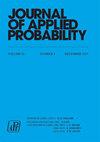赌徒破产博弈持续时间的随机排序结果
IF 0.7
4区 数学
Q3 STATISTICS & PROBABILITY
引用次数: 0
摘要
在经典的赌徒破产问题中,赌徒的对手分别以大写字母z和$a-z$开头,其中$a>0$和$0< z < a$是整数。在每一轮中,赌徒以p和$1-p$的概率赢或输一美元。游戏继续进行,直到两个玩家中的一个被毁。对于偶数a和$0<z\leq {a}/{2}$,以$p \in [0,{\frac{1}{2}}]$为索引的游戏持续时间(总回合数)的分布族显示为单调(增加)似然比,而对于${a}/{2} \leq z<a$,以$p \in [{\frac{1}{2}}, 1]$为索引的持续时间的分布族具有单调(减少)似然比。特别是,对于$z={a}/{2}$,就似然比顺序而言,持续时间的分布通过$p={\frac{1}{2}}$在$p \in [0,1]$上最大化。奇数a的情况也考虑通常的随机顺序。此外,作为极限,简要讨论了布朗运动的第一退出时间。本文章由计算机程序翻译,如有差异,请以英文原文为准。
Stochastic ordering results on the duration of the gambler’s ruin game
Abstract In the classical gambler’s ruin problem, the gambler plays an adversary with initial capitals z and $a-z$ , respectively, where $a>0$ and $0< z < a$ are integers. At each round, the gambler wins or loses a dollar with probabilities p and $1-p$ . The game continues until one of the two players is ruined. For even a and $0
求助全文
通过发布文献求助,成功后即可免费获取论文全文。
去求助
来源期刊

Journal of Applied Probability
数学-统计学与概率论
CiteScore
1.50
自引率
10.00%
发文量
92
审稿时长
6-12 weeks
期刊介绍:
Journal of Applied Probability is the oldest journal devoted to the publication of research in the field of applied probability. It is an international journal published by the Applied Probability Trust, and it serves as a companion publication to the Advances in Applied Probability. Its wide audience includes leading researchers across the entire spectrum of applied probability, including biosciences applications, operations research, telecommunications, computer science, engineering, epidemiology, financial mathematics, the physical and social sciences, and any field where stochastic modeling is used.
A submission to Applied Probability represents a submission that may, at the Editor-in-Chief’s discretion, appear in either the Journal of Applied Probability or the Advances in Applied Probability. Typically, shorter papers appear in the Journal, with longer contributions appearing in the Advances.
联系我们:info@booksci.cn
Book学术提供免费学术资源搜索服务,方便国内外学者检索中英文文献。致力于提供最便捷和优质的服务体验。
Copyright © 2023 布克学术 All rights reserved.
京ICP备2023020795号-1
 京公网安备 11010802042870号
京公网安备 11010802042870号
京ICP备2023020795号-1

Book学术文献互助群
群 号:604180095

 求助内容:
求助内容: 应助结果提醒方式:
应助结果提醒方式:
